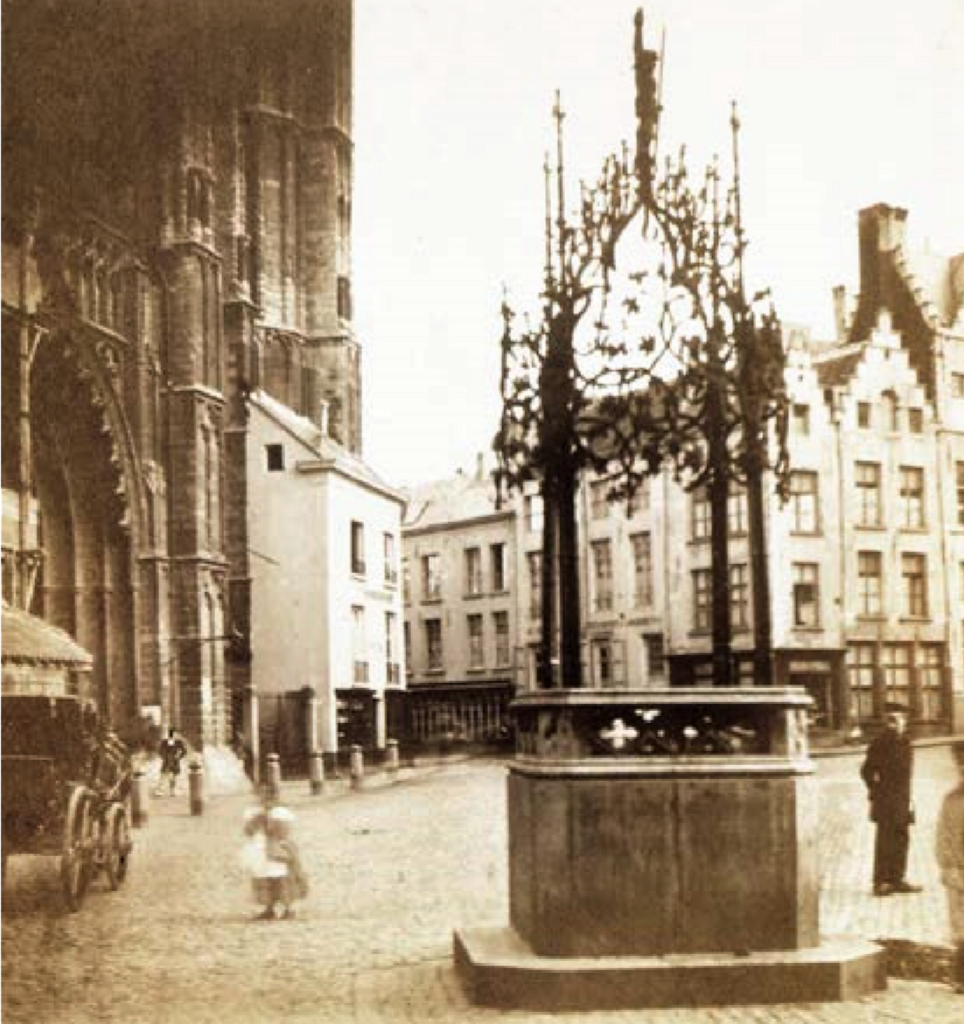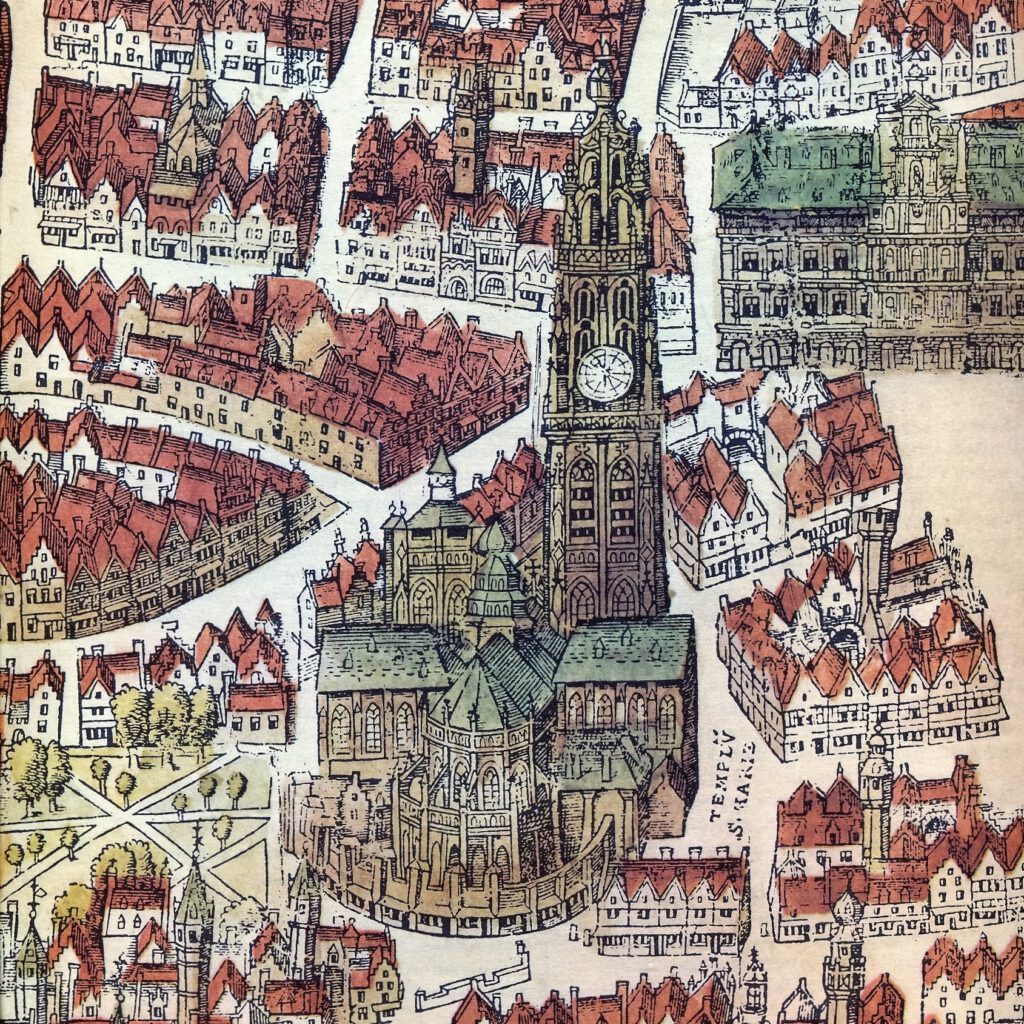The Our Lady’s Cathedral of Antwerp, a revelation.
A cathedral never stands alone
Your visit to the cathedralThe main church of a diocese, where the bishop’s seat is. does not start at the entrance door, but already from a great distance when you catch sight of the tall spire, from a plane, from the motorway or as a pedestrian in the narrow streets that surround it. Moreover a cathedral (A) never stood alone. We have a somewhat distorted view of such a church when we look at it as a monument, not connected with its environment, so that we cannot see the social and cultural influence it had and used to have. The Great Market Place with its craft and guild houses and the town hall constituted the economic and political centre, but the main church and its annexes were the heart of many socio-cultural bodies. In this way both lungs of the city have been side by side for centuries.
Houses
The official residence of the parish priestA priest in charge of a parish. (also deanPriest – usually a parish priest himself – who coordinates the work of several neighbouring parishes [a deanery].) (B), now in Sint-Pietersstraat 1 nearby, used to be where now the entrance to the car park at the side of Eiermarkt is. Until the French Rule the canons preferred to have their houses (C) around the vast Green Graveyard, whereas most smaller houses of the church hands (D) could be found at the feet of the towers and against the church wall. By having houses constructed against its walls the cathedral became as it were fused with its urban environment. The urban development view of treating the church separately as a monument, inspired the complete dismantlement of the surrounding houses. Nevertheless only the houses against the Western façade were pulled down in 1860 and 1887, and those in Blauwmoezelstraat in 1859 and 1876.
After the foundation of the Antwerp diocese in 1559 the refuge house of the Hemiksem SaintThis is a title that the Church bestows on a deceased person who has lived a particularly righteous and faithful life. In the Roman Catholic and Orthodox Church, saints may be venerated (not worshipped). Several saints are also martyrs. Bernard’s abbeyA set of buildings used by monks or nuns. Only Cistercians, Benedictines, Norbertines and Trappists have abbeys. An abbey strives to be self-sufficient. became the bishop’s house (E). In the 18th century Engelbert Baets constructed the present Classicist palace, which still is the bishop’s official residence and houses the offices of the bishopric.
The graveyards
Also the dead stayed here for a while. We must not forget that several graveyards used to belong to this church. The largest one was named after the grass, below which 80% of the parishioners were laid anonymously: the ‘Green Graveyard’ (M1). The street leading to it is still called Groenkerkhofstraat (Green Graveyard Street). Emperor Joseph II’s decree to forbid graveyards in cities out of hygienic concern in 1784 gave rise to the present ‘Groenplaats’ (Green Square) in 1799. The ‘Stone Graveyard’ (M2), to the West of the church, was cleared much earlier, in 1617. On this occasion art lover Cornelis van der Geest was the zealous advocate of preserving Quinten Matsys’s tombstone. It was attached vertically to the buttress of the big tower and thus it unintentionally became the first public monument for a citizen of this town.
Social works
In the beginning of the 13th century, true to medieval tradition, a hospital was founded near the then Romanesque church – the ‘house of God’. In popular speech this was called the ‘guest house (of God)’, where, inspired by Jesus’s interpretation of the ‘Works of Mercy’ the poor, destitute sick were received as guests and in them Jesus Himself. In 1238 this ‘Our Lady’s Hospital’ (F) moved to the vaster plot of Elzenveld at the present Lange Gasthuisstraat, where it developed into a real compound with an adjacent conventComplex of buildings in which members of a religious order live together. They follow the rule of their founder. The oldest monastic orders are the Carthusians, Dominicans, Franciscans, and Augustinians [and their female counterparts]. Note: Benedictines, Premonstratensians, and Cistercians [and their female counterparts] live in abbeys; Jesuits in houses. for the Augustinian Sisters and where it got a new patron saint: Saint Elisabeth.
In the house ‘De Tafel van de Heilige Geest’ (Holy Spirit’s Table) (G), in ‘Heilige Geeststraat’ (Holy SpiritThe active power of God in people. It inspires people to make God present in the world. Jesus was ‘filled with the Holy Spirit’ and thus showed in his speech and actions what God is like. People who allow the Holy Spirit to work in them also speak and act like God and Jesus at those moments. See also ‘Pentecost’. Street), which was given its name after it, the poor could be helped mainly with food, but also footwear and peat, very often in exchange for the appropriate poor tokens they had been given in the church. In fact this 13th century foundation was the predecessor of the present-day OCMW (Public Centre for Social Welfare). Today those in need for a talk can go to ‘De Open Deur’ (Open Door) (H1) in 1 Pelgrimsstraat, and for existential questions there is ‘Luisterhuis Aanwezigheid’ (Listening House Presence) (H2) above Schoenmakerskapel (Shoemakers’ chapel
A small church that is not a parish church. It may be part of a larger entity such as a hospital, school, or an alms-house, or it may stand alone.
An enclosed part of a church with its own altar.
) in 8 Schoenmarkt.
Education & Culture
The oldest free public school in Antwerp, which already dates back to before 1219, was the so-called ‘papenschool’ in ‘Papenstraat’. Both were named after the parochial clergy, which were called ‘papen’. This Latin school gave secondary education, between the elementary ‘Dietsche school’ (‘Dutch school’) and university, or ‘Hogeschool’ (‘High School’). Later this parish school was situated above the cannon’s wine cellar. When among others Balthasar Moretus and Rubens went to school there in 1589-1590 it was temporarily at Melkmarkt.

Since 1421 the Choraelhuys (ChoirIn a church with a cruciform floor plan, the part of the church that lies on the side of the nave opposite to the transept. The main altar is in the choir. Singers’ House) (J) had been at Melkmarkt, near the just finished choir. As usual there were averagely about eight choir singers, who lived there with their singing master. Until the 18th century it was a daily familiar view to see them walking to the church along Groenplaats in their purple cassocks and with their birettas. The ‘Choraelhuys’ was re-established in 1973 as a house for practice for the Antwerp Cathedral Choir and today it is situated in the parish centre, 21 Heilige Geeststraat.
In 1608 the chapterAll the canons attached to a cathedral or other important church, which is then called a collegiate church. In religious orders, this is also the meeting of the religious, in a chapter house, with participants having ‘a voice in the chapter’. decided to found the first public library (K). At first it was in the Papenhof (p.29) and afterwards in the seminary, which was more accessible. This project was promoted by CanonSomeone who, together with other canons, is attached to a cathedral or collegiate church and whose main task is to ensure choral prayer. Aubert le Mire (Miraeus). By the way, the books he owned formed the first core of the city library, now the Hendrik Conscience Heritage Library.
The seminary (L) of the Antwerp diocese was in Groenkerkhofstraat, near the bishop’s palace. In the 18th century it moved to an ample mansion nearby.
The revenues needed were provided by the renowned Our Lady’s Cloisters (N), an art market, consisting of covered galleries surrounding an open square, just like the stock market. In this commercial spot, founded in 1460, for example the famous Antwerp retables were exhibited hoping to find buyers. In 1560, exactly one century later, the cloisters were pulled down to lay out Korte and Lange Pandstraat, because letting houses there was more profitable.




